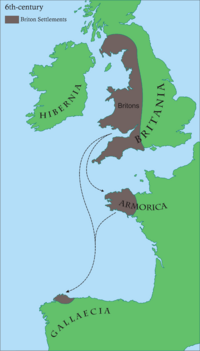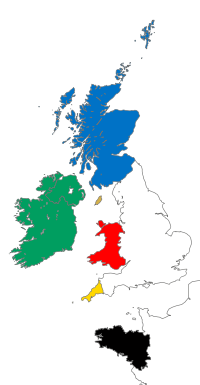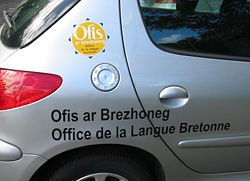Breton language
| Breton Brezhoneg |
||
|---|---|---|
| Pronunciation: | /bɾɛ.ˈzõː.nɛk/ | |
| Spoken in: | France | |
| Region: | Brittany | |
| Total speakers: | 200,000 - 300,000 [1] | |
| Language family: | Indo-European Celtic Insular Celtic Brythonic Breton |
|
| Language codes | ||
| ISO 639-1: | br | |
| ISO 639-2: | bre | |
| ISO 639-3: | bre | |
| Note: This page may contain IPA phonetic symbols in Unicode. | ||
The Breton language (Brezhoneg), formerly often called Armoric or Armorican, is a Celtic language spoken by some of the inhabitants of Brittany (Breizh/Bretagne) in France.
Contents |
History


Breton is descended from the Brythonic branch of Insular Celtic languages brought by Romano-British settlers to Brittany, perhaps from the end of the 3rd century onwards. The modern-day language most closely related to Breton is Cornish, followed by Welsh. (The other regional language of Brittany, Gallo, is a Langue d'oïl derived from Latin.)
Breton is spoken in Lower Brittany, roughly to the west of a line linking Plouha and La Roche-Bernard (east of Vannes). It comes from a Celtic language community (see image) between Great Britain and Armorica (present-day Brittany), and even Galicia. It was the language of the elite until the 12th century. However, afterwards it was only the language of the people of West Brittany (Breizh Izel), and the nobility, then successively the bourgeoisie, adopted French. As a written language, the Duchy of Brittany used Latin, switching to French in the 15th century. There exists a limited tradition of Breton literature. Old Breton has left some vocabulary which has served in the present day to produce philosophical and scientific terms in Modern Breton.
The French Monarchy did not concern itself with the minority languages of France. The revolutionary period saw the introduction of policies favouring French over the regional languages, pejoratively referred to as patois. It was assumed by the revolutionaries that reactionary and monarchist forces preferred regional languages in an attempt to keep the peasant masses under-informed. Under the Third, Fourth and Fifth republics, humiliating practices geared towards stamping out Breton language and culture[2] prevailed in state schools until the late 1960s.
Today, despite the political centralization of France and the important influence of the media, Breton is still spoken as an everyday language by about 200,000 people.[1] This is, however, down from 1.3 million in 1930. At the beginning of the 20th century, half the population of Lower Brittany knew only Breton, the other half being bilingual. By 1950, there were only 100,000 monolingual Bretons, with even fewer nowadays.[3] A statistical survey[4] performed in 1997 found around 300,000 speakers in Breizh izel, of which about 190,000 were aged 60 or over. Few of those of the 15-19 year-old age-group spoke Breton. Breton is now considered to be an endangered language.
In 1925, thanks to Professor Roparz Hemon, the first issue appeared of the review Gwalarn. During its 19-year run, Gwalarn tried to raise the language to the level of other great “international” languages by creating original works covering all genres and by proposing Breton translations of internationally-recognized foreign works.
In 1946, Al Liamm replaced Gwalarn. Other periodicals appeared and began to give Breton a fairly large body of literature for a minority language.
In 1977, Diwan schools were founded to teach Breton by immersion. They taught a few thousand young people from elementary school to high school. See the education section for more information.
The Asterix comic series has been translated into Breton. This is notable because, according to the comic, the Gaulish village where Asterix lives is in the Armoric peninsula, which is now Brittany. Some other comics have also been translated into Breton, including Tintin, Spirou, Titeuf, Hägar the Horrible, Peanuts and Yakari.
Some movies (Lancelot, Shakespeare in Love, Marion du Faouet, Sezneg) and TV series (Columbo, Perry Mason) are also broadcast in Breton.
Some poets, linguists, and writers who have written in Breton, for example Yann-Ber Kalloc'h, Roparz Hemon, Anjela Duval, Pêr-Jakez Helias and Youenn Gwernig, are now known internationally.
Today, Breton is the only living Celtic language which is not recognized as an official language. The French State refuses to change the second article of the Constitution (added in 1994), which states that “the language of the Republic is French”.
The first Breton dictionary, the Catholicon, was also the first French dictionary. Edited by Jehan Lagadec in 1464, it was a trilingual work containing Breton, French and Latin. Today the existence of bilingual dictionaries directly from Breton into languages such as English, Dutch, German, Spanish and Welsh demonstrates the determination of a new generation to gain international recognition for Breton. There also exists a monolingual dictionary, Geriadur Brezhoneg an Here, defining Breton words in Breton (first edition of 1995 contains about 10 000 words and the second 2001 edition contains 20 000 words).
Geographic distribution and dialects

Breton is spoken mainly in Western Brittany, but also in a more dispersed way in Eastern Brittany (where Gallo is spoken alongside Breton and French), and in areas around the world which have received Breton emigrants.
The dialects of Breton as identified by ethnologists are Leoneg, Tregerieg, Gwenedeg, and Kerneveg (in French, respectively: léonard, trégorrois, vannetais, and cornouaillais). There are no clear borders between those dialect areas because the language varies slightly from one village to the next. Compared to the other dialects, the Gwenedeg dialect is somewhat more distinct due to several pronunciation specificities.
Official status


Breton is not an official language of France, despite pleas from autonomists and others for official recognition and for the language to be guaranteed a place in schools, the media, and other aspects of public life.
But, in July 2008, the French Constitution has been added an article 75-1, stating les langues régionales appartiennent au patrimoine de la France (the regional languages belong to the heritage of France). This is an important step in the recognition of Breton and other minority languages of France, however, it doesn't explicitly give more actual recognition or power to these languages.
Nevertheless, the regional and departmental authorities do use Breton to a very limited extent, for example in signage. Some bilingual signage may also be seen, such as street name signs in Breton towns, and one station of the Rennes metro system has signs in both French and Breton.
Education

An attempt by the French government to incorporate the independent Breton-language immersion schools (called Diwan) into the state education system was blocked by the French Constitutional Council on the grounds that, as the 1992 amendment to the Constitution of the 5th Republic states that French is the language of the Republic, no other language may be used as a language of instruction in state schools. The Toubon Law states that French is the language of public education, which means that Breton-language schools do not receive funding from the state, though the Bretagne Region funds bilingual schools.
The Diwan schools were founded in 1977 to teach Breton by immersion. They taught a few thousand young people from elementary school to high school. They gained more and more fame due to their high level of results in school exams.[6]
Another teaching method is a bilingual approach by Div Yezh ("Two Languages") in the State schools, created in 1979, and Dihun ("Awakening") in the Catholic schools, created in 1990.
Statistics
| Year | Number | Percentage of all students in Brittany |
|---|---|---|
| 2005 | 10,397 | 1.24% |
| 2006 | 11,092 | 1.30% |
| 2007 | 11,732 | 1.38% |
| 2008 | 12,333 | ± 1.4% |
In 2008, 12,333[7] students (about 1.4% of all students in Brittany) attended Diwan, Div Yezh and Dihun schools, a number which is rapidly growing yearly. The president of the Regional Council, Jean-Yves Le Drian wanted the number to be 20,000 in 2010, though this is unlikely to be realised.[8]
Some 4,500 to 5,000 adults followed a Breton language course (evening course, correspondence, ...) in 2007. The family transmission of Breton in 1999 is estimated to be only 3%.[7]
See the statistics at dihun.com for graphics about the three systems.
Sounds
| Bilabial | Labiodental | Alveolar | Postalveolar | Palatal | Labiopalatal | Velar | Labiovelar | Glottal | |
|---|---|---|---|---|---|---|---|---|---|
| Plosive | pʰ b | tʰ d | cʰ ɟ | kʰ ɡ | |||||
| Nasal | m | n | ɲ | ŋ | |||||
| Trill | r | ||||||||
| Fricative | f v | s z | ʃ ʒ | x | h | ||||
| Approximant | j | ɥ | w | ||||||
| Lateral | l | ʎ |
Grammar
Verbal aspect
As in English and Irish, verbs have grammatical aspect, showing a distinction between progressive and habitual actions:
| Me zo o komz gant ma amezeg | "I am talking with my neighbour" |
| Me a gomz gant ma amezeg [bep mintin] | "I talk with my neighbour [every morning]" |
"Conjugated" prepositions
As in other modern Celtic languages, Breton pronouns are fused into preceding prepositions to produce a sort of "conjugated" preposition. Below are some examples in Breton, Welsh, and Irish. In Literary Welsh this prepositional form is often at the end of the sentence as in other Celtic languages.
| Breton | Welsh (Northern) | Irish | Scottish Gaelic | English |
|---|---|---|---|---|
| ul levr zo ganin a book is with-me |
mae gen i lyfr | tá leabhar agam | tha leabhar agam | I have a book |
| ur banne zo ganit a drink is with-you |
mae gennyt ti ddiod | tá deoch agat | tha deoch agad | you have a drink |
| un urzhiataer zo gantañ a computer is with-him |
mae ganddo fo gyfrifiadur | tá ríomhaire aige | tha coimpiutair aige | he has a computer |
| ur bugel zo ganti a child is with-her |
mae ganddi hi blentyn | tá páiste aici | tha pàisde aice | she has a child |
| ur c'harr zo ganimp (or ganeomp) a car is with-us |
mae gennym ni gar | tá gluaisteán againn | tha càr againn | we have a car |
| un ti zo ganeoc'h a house is with-you |
mae gennych chi dŷ | tá teach agaibh | tha taigh agaibh | you [pl] have a house |
| arc'hant zo ganto (or gante) money is with-them |
mae ganddyn nhw arian | tá airgead acu | tha airgead aca | they have money |
Note that in the examples above the Goidelic languages (Irish and Scottish Gaelic) use the preposition meaning "at" to show possession while the Brythonic languages use "with".
Initial consonant mutations
Breton has four initial consonant mutations: though modern Breton lost the nasal mutation of Welsh, it also has a 'hard' mutation, in which voiced stops become voiceless, and a 'mixed' mutation, which is a mixture of hard and soft mutations.
| Consonant | Mutations | |||
|---|---|---|---|---|
| Soft | Aspirant | Hard | Mixed | |
| p | b | f | ||
| t | d | z | ||
| k | g | c'h | ||
| b | v | p | v | |
| d | z | t | t | |
| g | c'h | k | c'h | |
| gw | w | kw | w | |
| m | v | v | ||
Vocabulary
- Some words passed in French and in English
The English words dolmen and menhir have been borrowed from French, which supposedly took them from Breton. However, this is uncertain: for instance, menhir is peulvan or maen hir ("long stone"), maen sav ("straight stone") (two words : noun + adjective) in Breton. Dolmen is a misconstructed word (it should be taol-vaen). Some studies state that these words were borrowed from Cornish. Maen hir can be directly translated from Welsh as "long stone" (which is exactly what a menhir or maen hir is).
Orthography
The first Breton texts, contained in the Leyde manuscript, were written at the end of the 8th century: fifty years prior to the Strasbourg Oaths, considered to be the earliest example of French. After centuries of orthography calqued on the French model, in the 1830s Le Gonidec created a modern phonetic system.
During the early years of the 20th century, a group of writers known as Emglev ar Skrivanerien elaborated and reformed Le Gonidec's system, making it more suitable as a super-dialectal representation of the dialects of Cornouaille, Leon and Trégor. This KLT (from Kernev, Leon and Treger, the Breton names for Cornouaille, Leon and Trégor) orthography was established in 1911. At the same time writers using the more divergent Vannetais dialect developed a system also based on that of Le Gonidec to represent their dialect.
Following proposals made during the 1920s, the KLT and Vannetais orthographies were merged in 1941 to create an orthographic system which could represent all four dialects. One of the most salient features of this Peurunvan wholly unified orthography was the inclusion of the <zh> digraph, which represents a /h/ in Vannetais which corresponds to a /z/ in the KLT dialects. This digraph also provides an alternate name for the orthography: Zedacheg i.e. ZH-ish.
In 1955 a new orthography was proposed by François Falc'hun and the group Emgleo Breiz, which had the aim of using a set of graphemes closer to the conventions of French. This Orthographie Universitaire ("University Orthography", known in Breton as Skolveurieg) was given official recognition by the French authorities as the "official orthography of Breton in French education". This orthography was met with strong opposition and is largely only used by the magazine Brud Nevez and the publishing house Emgléo Breiz.
Between 1971 and 1974 a new standard orthography has been devised - the etrerannyezhel or interdialectale. This system is based on derivation of the words.
Today the majority of writers continue to use the Peurunvan orthography, including most Breton-language schools.
Differences between Skolveurieg and Peurunvan
Both orthographies make use of the Latin alphabet, with the supplemental signs â, ê, î, ñ, ô, û, ù, ü, and é which is used only in Skolveurieg.
Differences between the two systems are particularly noticeable in word endings. In Peurunvan final obstruents which are devoiced in absolute final position and voiced in sandhi before voiced sounds are represented by a grapheme indicating a voiceless sound. In OU they are written as voiced but represented as voiceless before suffixes: braz big, brasoh bigger.
In addition, Peurunvan maintains the KLT convention which distinguishes noun/adjective pairs with nouns written with a final voiced consonant and adjectives with a voiceless one. There is, however, no distinction in pronunciation, e.g. brezhoneg Breton language vs. brezhonek Breton (adj).
Some examples of words in the different orthographies:
| Etrerannyezhel (1975) | Peurunvan (1941) | Skolveurieg (1956) |
| glaw | glav | glao |
| piw | piv | piou |
| levr | levr | leor |
| ewid | evit | evid |
| gant | gant | gand |
| anezhi | anezhi | anezi |
| ouzhpenn | ouzhpenn | ouspenn |
| brawañ | bravañ | brava |
| pelec'h | pelec'h | peleh |
Examples

Visitors to Brittany may encounter words and phrases (especially on signs and posters) such as the following:
| Breton | English |
|---|---|
| degemer mat | welcome |
| deuet mat oc'h | you're welcome |
| Breizh | Brittany |
| brezhoneg | Breton (language) |
| ti, "ty" | house |
| ti-kêr | town hall |
| kreiz-kêr | town centre |
| da bep lec'h | all directions |
| skol | school |
| skol-veur | university |
| bagad | pipe band (nearly) |
| fest-noz | lit. "night fête", a fest deiz or "day fête" also exists |
| kenavo | goodbye |
| krampouezh | pancakes (a pancake = ur grampouezhenn) |
| chistr | cider |
| chouchenn | Breton mead |
| war vor atao | always at sea |
| kouign amann | rich butter and sugar cake |
See also
- Bretagne and Brittany
- List of Celtic language media
- Armorica
- Armoricani
- Julian Maunoir, 17th. century Breton language orthographer
- Celtic nations
- Welsh language
- Irish language revival
External links
- The official website of Ofis ar Brezhoneg
Dictionaries
Learning
- Breton site including online lessons
- Breton site with learners' forum and lessons (mostly in French with some English)
Other external links
- An interesting essay about the situation of the Breton language
- 100 Words relating to the internet in Breton
- Amsez Wask Breizh News in breton language from agence bretagne presse
- Bretagne Réunie
- BLOG BREIZH - Blog of information about Brittany with some interesting articles about Breton language
- A Taste of Breton Verse
- Irish and Breton language with Japanese translation incl.pronunciation sound files
- http://www.logosdictionary.com/pls/dictionary/new_dictionary.index_p A multilingual dictionary containing many Breton words alongside those of other languages
- Entry at Omniglot
References
- ↑ 1.0 1.1 The most recent census (2001) shows about 270,000 speakers, with a yearly decline of about 10,000 speakers. The site oui au breton estimates a number of about 200,000 current speakers.
- ↑ ICBL information about Breton
- ↑ Ethnologue report
- ↑ Fañch Broudic, Qui parle breton aujourd'hui? Qui le parlera demain? Brest: Brud Nevez, 1999
- ↑ Ofis ar Brezhoneg
- ↑ (French) Diwan FAQ, #6
- ↑ 7.0 7.1 (French) Données clés sur breton, Ofis ar Brezhoneg
- ↑ (French) Interview with Jean-Yves Le Drian, the president of the Region Council
|
|||||||||||||||||||
|
|||||||||||||||||||||||||||